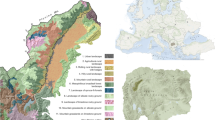Abstract
Incorporation of aesthetic considerations in the process of landscape planning and development has frequently met with poor results due to its lack of theoretical basis, public involvement, and failure to deal with spatial implications. This problem has been especially evident when dealing with large areas, for example, the Adirondacks, Scenic Highways, and National Forests and Parks. This study made use of public participation to evaluate scenic quality in a portion of the Niagara Escarpment in Southern Ontario, Canada. The results of this study were analyzed using thevisual management model proposed by Brown and Itami (1982) as a means of assessing and evaluating scenic quality. Themap analysis package formulated by Tomlin (1980) was then applied to this assessment for the purpose of spatial mapping of visual impact. The results of this study illustrate that it is possible to assess visual quality for landscape/management, preservation, and protection using a theoretical basis, public participation, and a systematic spatial mapping process.
Similar content being viewed by others
Literature cited
Brown, T. J., and R. M. Itami. 1982. Landscape principles study: procedures for landscape assessment and management—Australia.Landscape Journal 1:113–121.
Fabos, J. G. 1979. Planning the total landscape: a guide to intelligent land use. Westview Press, Boulder, Colorado, 181 pp.
Gimblett, H. R., R. M. Itami, and J. E. Fitzgibbon. 1985. Mystery in an informational processing model of landscape preference.Landscape Journal, 4, 2.
Hopkins, L. D. Methods for generating land suitability maps: a comparative evaluation.Journal of the American Institute of Planners. 43:386–400.
Kaplan, S., and R. Kaplan. 1982. Cognition and environment: functioning in an uncertain world. Praeger, New York, New York, 287 pp.
Kaplan, S., and J. S. Wendt. 1972. Preferences and the visual environment: complexity and some alternatives.In W. S. Mitchell (ed.)Environmental Design and Practice. Environmental Design Research Association, Washington, D.C., pp 681–685.
Pearce, S. R. and N. M. Water. 1983. Quantitative methods for investigating the variables that underlie preference for landscape scenes.Canadian Geographer XXVII, 4.
Shafer, E. L. Jr., J. F. Hamilton, and E. Schimdt. 1969. Natural landscape preferences: a predictive model.Journal of Leisure Research. 1(1): 1–19.
Tomlin, C. D. 1980. The map analysis package. Yale School of Forestry and Environmental Studies, New Haven, Connecticut.
Williamson, D. N. and J. A. Chalmers. 1982. Perceptions of forest scenic quality in northeast Victoria: a technical report of research phases I and II.Landscape Management Series. Forests Commission Victoria, Melbourne, Victoria, Australia.
Zube, E. H. 1973. Scenery as a natural resource.Landscape Architecture, 63, 2.
Author information
Authors and Affiliations
Rights and permissions
About this article
Cite this article
Gimblett, H.R., Fitzgibbon, J.E., Bechard, K.P. et al. Procedure for assessing visual quality for landscape planning and management. Environmental Management 11, 359–367 (1987). https://doi.org/10.1007/BF01867164
Issue Date:
DOI: https://doi.org/10.1007/BF01867164




